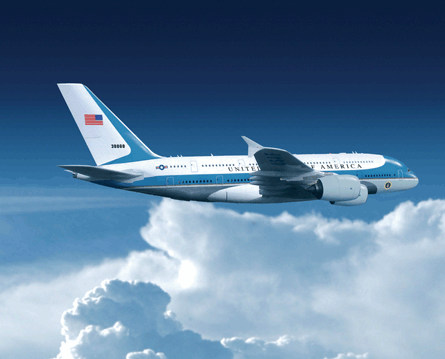The US Air Force yesterday took the first public step in the search for a replacement of the Boeing VC-25 Air Force One, the presidential aircraft fleet.
The USAF posted a request for information for market sources that can provide three widebody aircraft to replace two, 19-year-old VC-25s, which are converted Boeing 747-200s.
An analysis of alternatives performed in 2007, which identified the Airbus A380 as a candidate, found that it would be more cost-effective to buy new aircraft rather than modernize the VC-25s, the acquisition document says.
 |
|---|
© Gareth Burgess/Flight International |
The first “presidential aircraft replacement” must be delivered in 2017, followed by a second and third aircraft in 2019 and 2021.
The USAF’s options for commercially-derived widebody aircraft in that timeframe could be limited to the 747-8I and A380.
In October 2007, Airbus executives confirmed that they were invited by the USAF to submit data about the A380, A340 and A330 as part of an analysis of alternatives. EADS officials added that the company gave unprecedented access to the USAF for data about its commercial aircraft designs.
Asked for comment about the new RFI, an EADS spokesman replied: “We have received it and are taking a look. We’ll settle on a course of action after our review.”
In September, EADS North America publicly posted a recruitment advertisement for a business development manager to pitch Airbus aircraft designs for a variety of USAF programmes, including the Air Force One replacement.
In the past, Boeing executives have described retaining the Air Force One contract as one of the company’s top priorities.
“It is a very important program for the Boeing Company and we have been supporting for it more than 50 years so clearly we understand the presidential requirements,” a Boeing spokesman said.
Boeing delivered the first 707-based VC-137 Air Force One to the White House in 1962. The company also replaced those 28 years later with the VC-25s, which would be 27 years old at the time of their replacement.
“We are going to respond to the request for information and look forward to supporting our customer’s needs in the future,” Boeing’s spokesman said.
Boeing would compete from a position of long-term incumbency and as the sole domestic manufacturer of commercially-derived widebody aircraft.
But the US domestic industry’s dominance of the presidential aircraft fleet crumbled in 2004. A Lockheed Martin proposal based on the AgustaWestland EH101 – at the time, an Italian-Anglo manufacturer beat incumbent Sikorsky’s “All-American” H-92 proposal.
Transatlantic defence industry cooperation, however, was strained last year by the results of the KC-X tanker competition. Although Northrop Grumman proposal based on the A330-200 was selected by the USAF, the Government Accountability Office overturned the contract award on technical grounds.
Source: Flight International
















